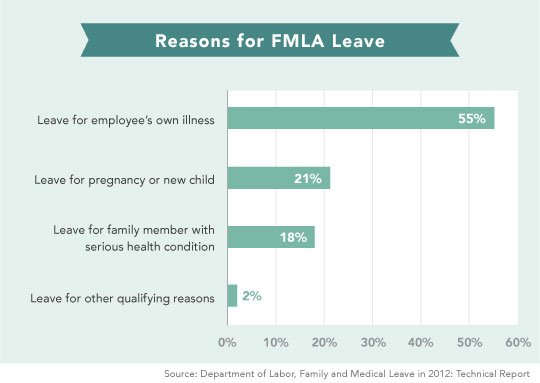You know that juggling a career and caregiving can be stressful. What you may not know is that the federal family leave law can help you balance these competing responsibilities.
The Family and Medical Leave Act (FMLA) was established to help workers maintain their jobs, health insurance, and financial security by guaranteeing up to 12-weeks of unpaid, job-protected leave to care for themselves or for a family member.
Although more than half of the workforce is eligible to receive leave, one in three workers is still unaware of the FMLA as a workplace standard (Source).
While there are eligibility requirements that must be met in order to receive leave under the FMLA, it’s important for caregivers to understand their rights to family leave.
FMLA is not just for new parents
People often think that the FMLA is just for parents who need time to bond with their new baby. Not so. FMLA leave can also be taken by employees who need to care for themselves or a family member with a serious health condition—that means your spouse, child, or parent.

You don’t have to be the primary caregiver to take FMLA leave
Even if you share caregiving responsibilities with siblings, use an outside home care agency, or are substituting for others who normally care for your family member, you may still be eligible to take FMLA leave with proper medical certification.
FMLA leave can be taken for planned and unplanned absences
Whether you’re accompanying your mother to chemotherapy treatments or taking your child to the doctor after an asthma flare-up, FMLA leave can be taken for both foreseeable and unforeseeable events. A healthcare provider will need to certify the need for intermittent leave. In general, you must also follow your employer’s normal procedures for requesting time off when possible and comply with notification requirements under the FMLA.
You can receive additional support from state family leave laws
A handful of states, including Hawaii, have expanded leave protections that go beyond the minimum federal requirements of the FMLA. For instance, the Hawaii Family Leave Law (HFLL), which provides eligible employees up to four weeks of unpaid family leave, also covers leave to care for an employee’s sibling, parent-in-law, grandparent, or grandparent-in-law (Source). One big difference, however, is that the HFLL does not cover an employee’s leave for their own serious health condition. Also, employers may designate certain leaves concurrently under FMLA and HFLL.
You may be able to get paid while on FMLA leave
While the FMLA provides a vital safety net for many, some caregivers can’t afford to take unpaid leave. However, the law allows you to (or your employer may require you to) use accrued paid vacation or sick leave for some or all of the FMLA leave period. If you do use paid leave during your designated FMLA leave, your leave is still FMLA-protected.
Keep in mind that not all employers are covered under the FMLA or HFLL, nor are all employees eligible to receive leave. To see if you are eligible, speak with your company’s HR department.


You know that juggling a career and caregiving can be stressful. What you may not know is that the federal family leave law can help you balance these competing responsibilities.
The Family and Medical Leave Act (FMLA) was established to help workers maintain their jobs, health insurance, and financial security by guaranteeing up to 12-weeks of unpaid, job-protected leave to care for themselves or for a family member.
Although more than half of the workforce is eligible to receive leave, one in three workers is still unaware of the FMLA as a workplace standard (Source).
While there are eligibility requirements that must be met in order to receive leave under the FMLA, it’s important for caregivers to understand their rights to family leave.
FMLA is not just for new parents
People often think that the FMLA is just for parents who need time to bond with their new baby. Not so. FMLA leave can also be taken by employees who need to care for themselves or a family member with a serious health condition—that means your spouse, child, or parent.

You don’t have to be the primary caregiver to take FMLA leave
Even if you share caregiving responsibilities with siblings, use an outside home care agency, or are substituting for others who normally care for your family member, you may still be eligible to take FMLA leave with proper medical certification.
FMLA leave can be taken for planned and unplanned absences
Whether you’re accompanying your mother to chemotherapy treatments or taking your child to the doctor after an asthma flare-up, FMLA leave can be taken for both foreseeable and unforeseeable events. A healthcare provider will need to certify the need for intermittent leave. In general, you must also follow your employer’s normal procedures for requesting time off when possible and comply with notification requirements under the FMLA.
You can receive additional support from state family leave laws
A handful of states, including Hawaii, have expanded leave protections that go beyond the minimum federal requirements of the FMLA. For instance, the Hawaii Family Leave Law (HFLL), which provides eligible employees up to four weeks of unpaid family leave, also covers leave to care for an employee’s sibling, parent-in-law, grandparent, or grandparent-in-law (Source). One big difference, however, is that the HFLL does not cover an employee’s leave for their own serious health condition. Also, employers may designate certain leaves concurrently under FMLA and HFLL.
You may be able to get paid while on FMLA leave
While the FMLA provides a vital safety net for many, some caregivers can’t afford to take unpaid leave. However, the law allows you to (or your employer may require you to) use accrued paid vacation or sick leave for some or all of the FMLA leave period. If you do use paid leave during your designated FMLA leave, your leave is still FMLA-protected.
Keep in mind that not all employers are covered under the FMLA or HFLL, nor are all employees eligible to receive leave. To see if you are eligible, speak with your company’s HR department.